Revision Notes: Organic Chemistry - Hydrocarbons | Chemistry Class 10 ICSE PDF Download
| Table of contents |

|
| Organic Chemistry |

|
| Hydrocarbons |

|
| Classification of Organic Compounds |

|
| Homologous Series |

|
| Isomers |

|
| Nomenclature |

|
| Functional Group |

|
| Alkanes |

|
| Alkenes |

|
| Alkynes |

|
| Alcohols |

|
| Carboxylic Acids |

|
Organic Chemistry
It is the chemistry of specific carbon compounds except oxides, carbonates and carbides.
Hydrocarbons
Organic compounds composed of carbon and hydrogen only.
Examples: Methane (CH4), ethane (C2H6)
Unique Nature of Carbon
Tetravalency of Carbon
- Carbon forms four covalent bonds by mutually sharing its four electrons with other atoms.
- It is hence tetravalent or exhibits tetravalency.
Catenation
- It is the tendency of an element to form chains of identical atoms.
- Catenation is maximum in carbon because the value of the C–C bond energy is maximum.
- Carbon undergoes self-linking forming straight, branched and closed chains.

- Catenation and tetravalency also result in the formation of single, double and triple bonds.

Classification of Organic Compounds
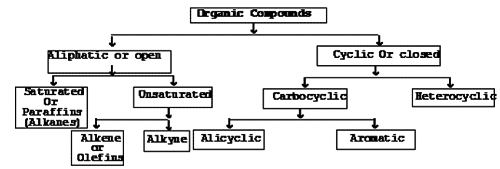
Homologous Series
It is a group of organic compounds with a similar structure and similar chemical properties in which the successive compounds differ by a CH2 group.
Characteristics of a homologous series
i. Each member of the series differs from the preceding one by the addition of a CH2 group and by 14 amu.
ii. All members of a homologous series share a general formula.
For example, the general formula for alkane is CnH2n+2 and that for alkene is CnH2n.
iii. The physical properties of the members show gradation in properties as molecular mass increases.
iv. The chemical properties also show gradient similarity.
For example, methane and ethane react with chlorine to form methyl chloride and ethyl chloride, respectively.
CH4 + Cl2 → CH3Cl
C2H6 + Cl2 → C2H5Cl
v. All members of a homologous series can be prepared by the same general method of preparation. For example, alcohols can be prepared from alkyl halides.

Significance of a Homologous Series
i. Helps in the systematic study of organic compounds.
ii. Predicts the properties and the nature of other elements of the series if the same is known of the first few members.
Isomers
Compounds with the same molecular formula but different structural formula are known as isomers, and the phenomenon is known as isomerism.Examples: Butane and isobutane are two different compounds with the same molecular formula C4H10.
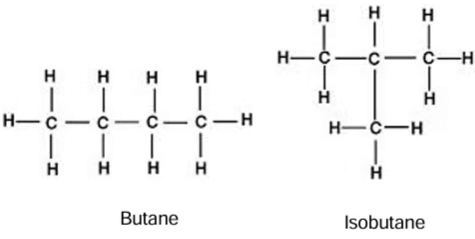
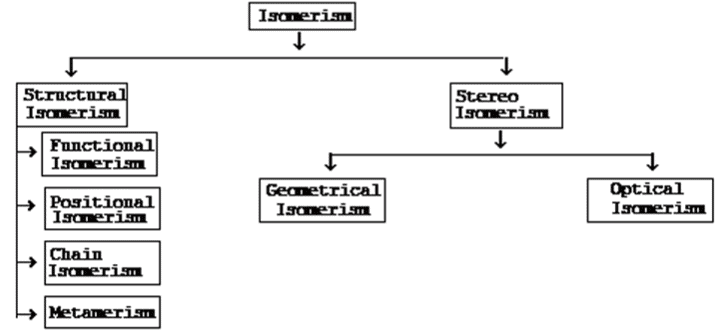
Causes of Isomerism
i. Difference in the mode of linking of atoms.
ii. Difference in the arrangement of atoms or groups in space.
Different Types of Structural Isomerism
i. Chain isomerism
Two or more compounds which have a similar molecular formula but different arrangement of carbon atoms in straight or branched chains are referred to as chain isomers, and the phenomenon is known as chain isomerism.
ii. Position isomerism
When two or more compounds with the same molecular formula differ in the position of the substituent atom or functional group on the carbon atom, they are called position isomers, and the phenomenon is known as position isomerism.
iii. Functional isomerism
Two or more compounds with the same molecular formula but different functional groups are called functional isomers, and the phenomenon is known as functional isomerism.
iv. Metamerism
It arises because of unequal distribution of alkyl groups on either side of the functional groups in the molecules.
Nomenclature
It is the system of assigning names to organic compounds.
The Systems of Nomenclature Are
i. Trivial system
ii. IUPAC (International Union of Pure and Applied Chemistry) system
According to the IUPAC system, the name of an organic compound consists of three parts:
i. Root word
ii. Suffix
iii. Prefix
i. Root word
It depends on the number of carbon atoms present in the longest carbon chain selected.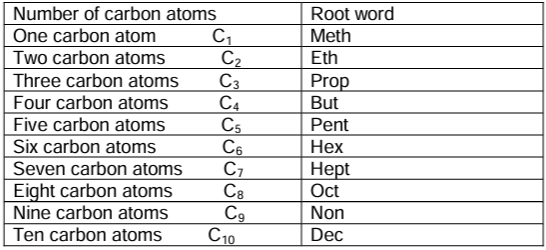
ii. Suffix
The root word is followed by an appropriate suffix, which represents the nature of the bond in a carbon–carbon atom.
iii. Prefix
It denotes the substituent, alkyl or functional group and its position in the carbon chain. Di-, tri- and tetra- are used for two, three and four groups of the same type, respectively.
Functional Group
It is an atom or a group of atoms which defines the structure (or the properties of a particular family) of organic compounds.
Characteristics of a Functional Group
i. Compounds of the same functional group are identified using the same types of tests.
ii. The physical and chemical properties of the compounds of different functional groups are different.
iii. There exists a homologous series of compounds containing a particular type of functional group.
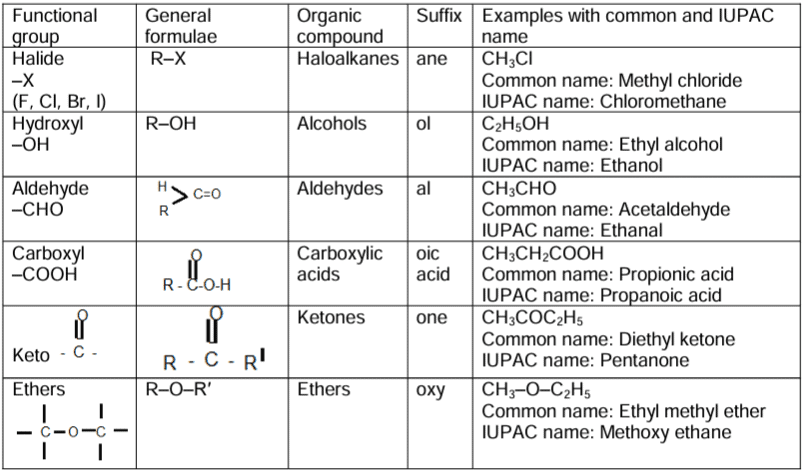
Alkanes
- Alkanes are hydrocarbons in which all the linkages between the carbon atoms are single covalent bonds.
- Compounds are known as saturated hydrocarbons because all the four valencies of carbon are fully satisfied.
- General formula : CnH2n+2
- These hydrocarbons are relatively unreactive under ordinary conditions so they are also called paraffins.
Isomerism in Alkanes
- Alkanes with more than three carbon atoms form isomers.
- The various isomers differ in the framework of the carbon chains.
Example: Isomers of Pentane (C5H12)
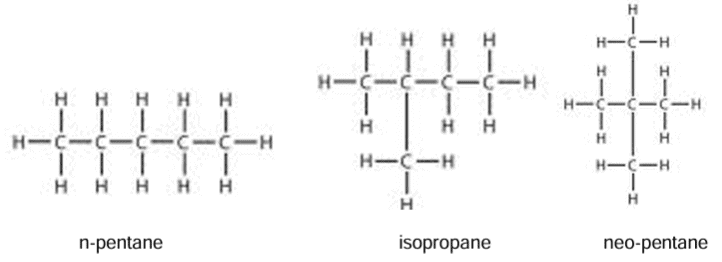
Laboratory Preparation of Methane and Ethane
CH3COONa + NaOH  Na2CO3 + CH4
Na2CO3 + CH4
C2H5COONa + NaOH  Na2CO3 + C2H6
Na2CO3 + C2H6
Methods of Preparation of Methane and Ethane
- From iodomethane or bromoethane:
CH3I + 2[H] → CH4 + HI
C2H5I + 2[H] → C2H6 + HI - Methane is produced on addition of water to aluminium carbide at room temperature.
Al4C3 + 12H2O → 3CH4 + 4Al (OH)3 - Ethane from alkyl halides:
2CH3I + 2Na CH3–CH3 + 2NaI
CH3–CH3 + 2NaI
This reaction is known as the Wurtz reaction.
Chemical Properties
- Substitution reaction
(i) Reaction with halogens
CH4 + Cl2 CH3Cl + HCl
CH3Cl + HCl
CH3Cl + Cl2 → CH2Cl2 + HCl
CH2Cl2 + Cl2 → CHCl3 + HCl
(ii) Reaction with oxygen
CH4 + 2O2 → CO2 + 2H2O
2C2H6 + 7O2 → 4CO2 + 6H2O
Insufficient supply of air
2CH4 + 3O2 → 2CO + 4H2O
2C2H6 + 5O2 → 4CO + 6H2O - Cracking or Pyrolysis

- Catalytic oxidation of alkanes
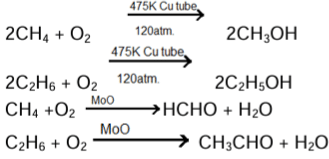
- Slow combustion

Alkenes
- Alkenes are unsaturated aliphatic hydrocarbons containing a carbon–carbon double bond.
- They are also called olefins because of their tendency to form oily products.
- The general formula of alkenes is CnH2n.
Structure of Ethene
- Two carbon atoms linked by a double covalent bond.
- A double covalent bond is formed by sharing of two pairs of electrons between the two carbon atoms.
- Four C–H single covalent bonds and one C=C double covalent bond.
- It is a planar molecule and all bond angles (H–C–H and H–C=C) are of 120°.
Preparation of Ethene
i. Dehydration of ethyl alcohol

ii. Dehydrohalogenation of ethyl bromide

iii. Cracking of methane

Chemical properties
Addition Reactions
(i) Catalytic hydrogenation 
(ii) Halogenation

(iii) Reaction with Halogen Acids

(iv) Reaction with Sulphuric acid

(v) Ozone

(vi) Oxidation

(vii) Polymerisation

Alkynes
- Alkynes are unsaturated aliphatic hydrocarbons containing a carbon–carbon triple bond in their molecule.
- The general formula of alkynes is CnH2n−2.
- They are more reactive than alkenes because of the presence of a triple bond, often referred to as an acetylenic linkage.
Structural formula of Ethyne
Preparation of Ethyne
i. Laboratory preparation from calcium carbide

ii. From 1, 2-dibromoethane

iii. From methane

Chemical Properties
- Addition Reactions
(a) Catalytic Hydrogenation (b) Halogenation
(b) Halogenation (c) Reaction with Halogen Acids
(c) Reaction with Halogen Acids (d) Ozone
(d) Ozone  (e) Oxidation of ethyne (Combustion)
(e) Oxidation of ethyne (Combustion)
Alcohols
- Alcohols are hydroxyl derivatives of alkanes obtained by replacement of one, two or three hydrogen atoms of alkanes by the corresponding number of –OH groups.
- The hydroxyl group is the functional group of alcohols.
- The general molecular formula of alcohols is CnH2n+1 OH.
Preparation of Ethanol
(i) Laboratory preparation by hydrolysis of alkyl halides

(ii) Industrial Method
(a) Hydration of Ethene

(b) Fermentation of Carbohydrates
Chemical properties
- Combustion
C2H5OH + 3O2 → 2CO2 + 3H2O - Oxidation with K2Cr2O7

- Reaction with Sodium
2C2H5OH + 2Na → 2C2H5ONa + H2 - Reaction with Acetic acid
C2H5OH + CH3COOH → CH3COOC2H5 + H2O - Reaction with Sulphuric acid

- Reaction with PCl
3C2H5OH + PCl3 → 3C2H5Cl + H3PO3
Carboxylic Acids
- Carboxylic acids are organic compounds containing a carboxylic group (–COOH) attached to an alkyl group or to a hydrogen atom.
- Representation of carboxylic acids: R-COOH (R is either –H or alkyl)
- The functional group of carboxylic acids: –COOH (carboxylic)
- The acidic character in carboxylic acids is because of the presence of the replaceable hydrogen atom in the carboxylic group.
Preparation of Acetic Acid
(A) By oxidation of ethyl alcohol

(B) By hydrolysis of ethyl acetate

Chemical Properties
- It is a weak acid and turns blue litmus red.
- Reaction with Alkalis
CH3COOH + NaOH → CH3COONa + H2O
CH3COOH + NH4OH → CH3COONH4 + H2O - Reaction with Carbonates
2CH3COOH + Na2CO3 → 2CH3COONa + H2O + CO2
CH3COOH + NaHCO3 → CH3COONa + H2O + CO2 - Reaction with Alcohols
CH3COOH + C2H5OH CH3COOC2H5 + H2O
CH3COOC2H5 + H2O - Reaction with PCl3
CH3COOH + PCl5 → CH3COCl + POCl3 + HCl - Reduction
CH3COOH + 4[H] →C2H5OH + H2O
|
39 videos|85 docs|14 tests
|
FAQs on Revision Notes: Organic Chemistry - Hydrocarbons - Chemistry Class 10 ICSE
| 1. What is the unique nature of carbon that allows it to form diverse organic compounds? |  |
| 2. What are the characteristics of a homologous series in organic chemistry? |  |
| 3. Why is the concept of a homologous series significant in organic chemistry? |  |
| 4. What are the primary causes of isomerism in organic compounds? |  |
| 5. What are the different types of structural isomerism, and how do they differ? |  |















